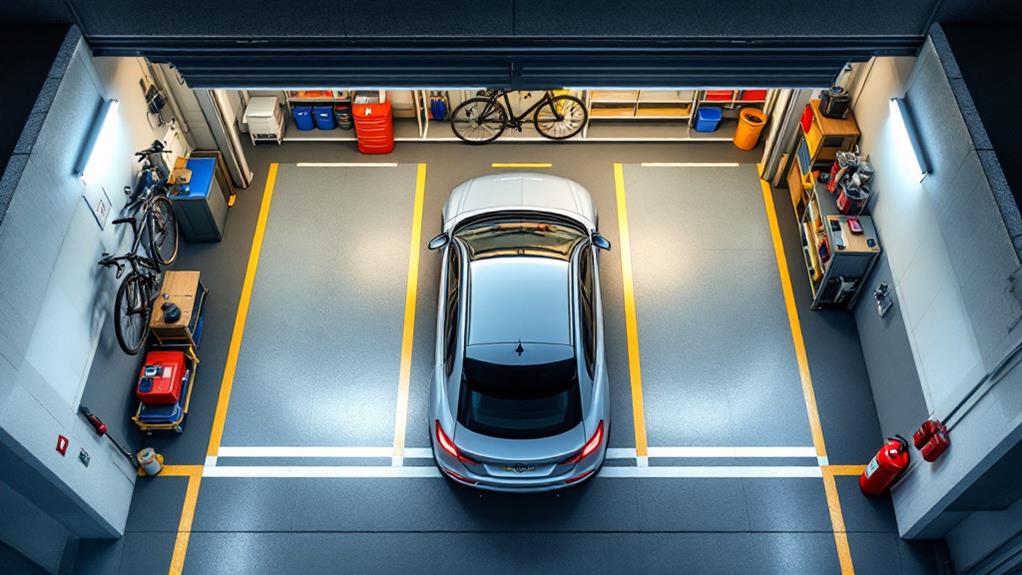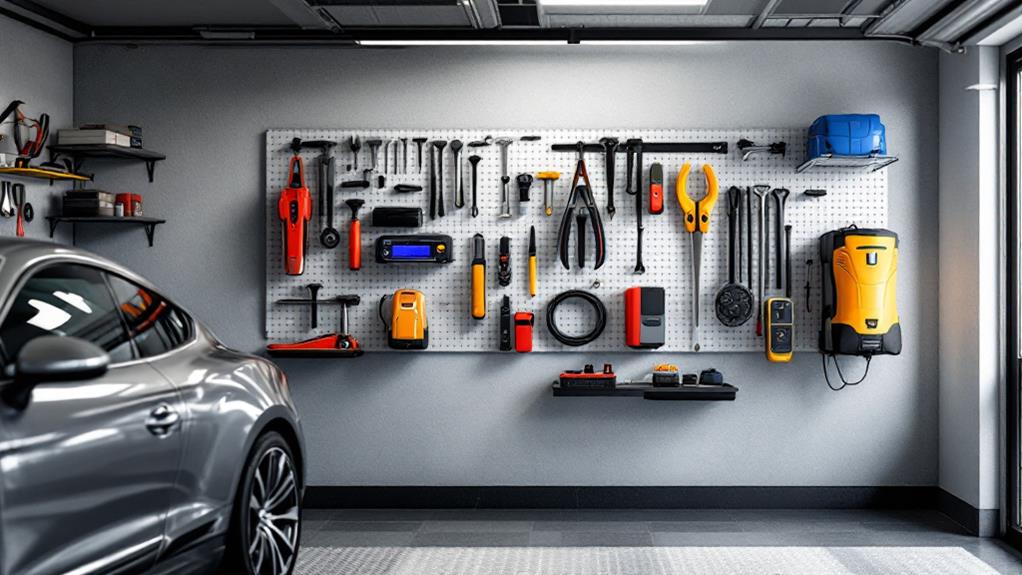Tips for Adding a Charging Station to Your Garage for EV Parking
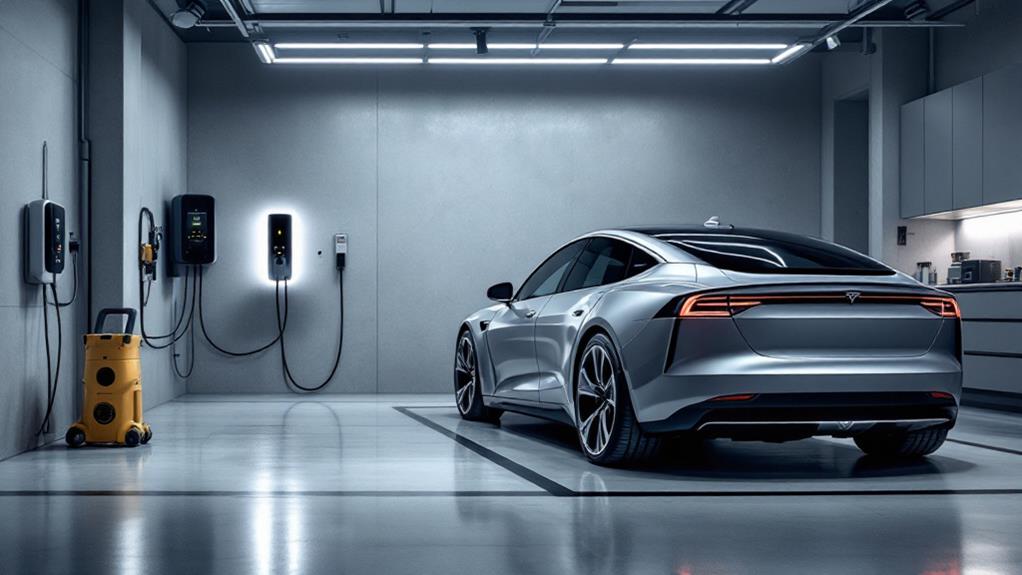
To add a charging station to your garage for EV parking, start by evaluating your home's electrical capacity. Choose a Level 2 charger that's compatible with your EV and electrical setup. Install the station within 15-20 feet of your vehicle's charging port, ideally at a height of 42-48 inches. Hire a licensed electrician for proper installation and permitting. Manage cables safely and consider weatherproofing for outdoor setups. Guarantee Wi-Fi connectivity for smart features and future-proof your installation by planning for potential upgrades. By maximizing energy efficiency and following these tips, you'll create an ideal charging setup. There's much more to investigate about enhancing your EV charging experience at home.
Assessing Your Garage's Electrical Capacity
Before diving into the installation of an EV charging station, it's imperative to assess your garage's electrical capacity. Start by determining the amperage and voltage of your home's electrical service. Most Level 2 charging stations require a 240V, 40-50A dedicated circuit, so you'll need to guarantee your electrical system can handle this load.
Next, evaluate your garage space to determine where you can install the necessary 240V outlet or hardwire the charging equipment. Consider the distance between your vehicle's charging port and the potential charger location. It's pivotal to consult a qualified electrician to evaluate your electrical panel's capacity and decide if any upgrades are needed to support your charging needs.
Factor in the distance between your electrical panel and the desired charger location, as longer cable runs can increase installation costs. Additionally, consider your specific EV model's power requirements when selecting a Level 2 charging station. This will help you choose the appropriate charging level and ensure your garage's electrical infrastructure can accommodate it. By thoroughly assessing these factors, you'll be well-prepared to add an efficient and safe charging solution to your garage.
Choosing the Right Charging Station
With the electrical capacity of your garage assessed, it's time to select the right charging station for your EV. Look for a Level 2 EV charging station that's safety certified and Energy Star compliant to guarantee efficiency and peace of mind. Smart chargers with Wi-Fi connectivity, scheduling features, and mobile app control offer added convenience and flexibility.
Consider your EV's battery capacity and desired charging speed when choosing a station. Most Level 2 chargers provide 10-20 miles of range per hour, so select one that meets your needs. Ensure compatibility with your garage's electrical service, as you'll need a dedicated 240V circuit installed by a licensed electrician.
Position your EV charging station within easy reach of your vehicle's charging port, typically 15-20 feet away. Opt for a model with good cable management to keep your garage tidy. Look for electric vehicle chargers that offer monitoring and charging history, as well as remote control through voice assistants or mobile apps.
Optimal Placement Within Your Garage
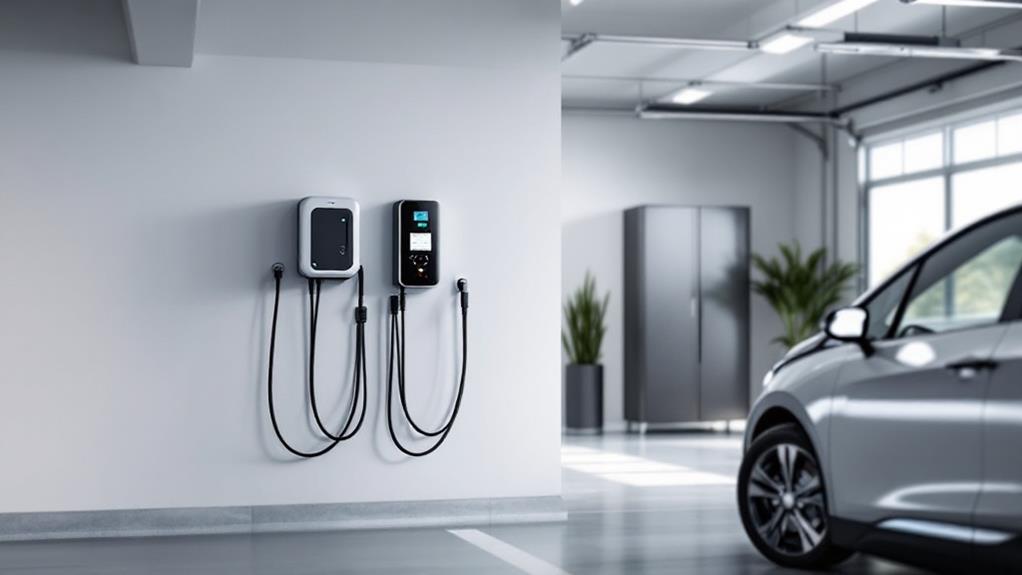
Positioning your EV charging station strategically within your garage guarantees convenient, efficient charging and maximizes available space. When deciding on the best location for your home EV charger, consider these key factors:
- Install the charger on the same side as your vehicle's charging port, within 15-20 feet to minimize cable length and reduce charging time.
- Mount the charger 42-48 inches high, at least 18 inches off the floor for easy access and convenience of charging.
- Place the charger and 240V outlet within 3-4 feet of each other to simplify installation.
- Ensure the charger is within range of your home's WiFi network or has cellular connectivity for remote management.
- For two EVs, mount the charger on a wall between the vehicles for equal access.
When deciding between garage or outside installation, the garage offers protection from the elements and added security. However, if space is limited, outdoor installation may be necessary. Remember to position your EV home charger where it won't interfere with other garage activities or storage. By carefully considering these factors, you'll create an efficient and user-friendly charging setup that enhances your EV ownership experience and maximizes the convenience of charging at home.
Permitting and Professional Installation
The red tape of permitting and the knowledge of professional installation are essential steps in adding an EV charging station to your garage. You'll need permits for both indoor and outdoor installations, and it's best to let an experienced electrician handle this process to avoid complications. Hiring a licensed electrician for professional installation isn't just recommended—it's indispensable for safety and code compliance.
A professional installer will guarantee proper electrical work, handle permitting, and make sure your charging station meets local building codes. They're also responsible for correcting any issues that arise during installation and covering associated costs. This peace of mind is priceless compared to the potential dangers and costly mistakes of DIY installations.
Don't underestimate the importance of proper permitting and professional installation. These steps are vital to avoid safety hazards and ensure your EV charging station functions correctly and reliably. Remember, building codes and requirements can vary by location, so having an expert navigate these complexities is key to a successful installation. By prioritizing professional help, you'll create a safe, efficient, and code-compliant charging solution for your electric vehicle.
Cable Management and Safety
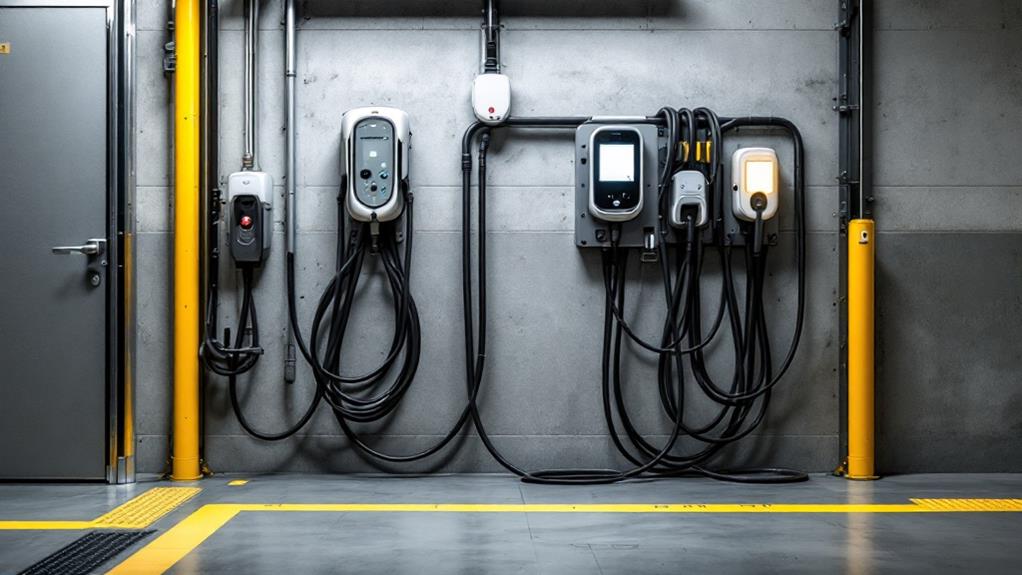
After installing your EV charging station, proper cable management is essential for safety and convenience. You'll want to make sure your charging cables are secure and organized to prevent tripping hazards and potential damage. If your charging station is outside the garage, ensure the cables are rated for outdoor use to withstand the elements.
To keep your garage floor clear and safe, consider using cable management accessories such as:
- Cable holders
- Hooks
- Reel systems
- Cable guides
- Wall-mounted organizers
These tools will help you keep cables off the floor and neatly stored when not in use. It's paramount to avoid routing cables through high-traffic areas in your garage to minimize the risk of accidents.
Regularly inspect your charging cables for signs of wear or damage. If you notice any issues, replace the cables immediately to maintain the safety and efficiency of your charging station. By implementing these cable management strategies, you'll create a safer environment in your garage and prolong the life of your charging equipment. Remember, a well-organized charging setup not only enhances safety but also improves the overall functionality of your EV parking space.
Weather Protection for Outdoor Chargers
While indoor charging stations benefit from a controlled environment, outdoor chargers face unique challenges. When installing an EV charger outside your garage, you'll need to prioritize weather protection to verify safe and reliable operation.
Choose a charger designed specifically for outdoor use, featuring weatherproof enclosures and materials that can withstand prolonged exposure to rain, snow, wind, and extreme temperatures. Look for models with additional safety features like ground fault protection and theft deterrents to prevent damage and unauthorized access.
Proper siting and installation are pivotal to minimize weather-related issues. Select a location that offers some natural protection from the elements, such as under an overhang or awning. Confirm proper drainage to prevent water accumulation around the charger's base.
During installation, use weatherproof conduits and sealed connections to protect against water intrusion. Consider adding a protective cover or canopy for extra shielding from direct sunlight and precipitation.
Remember that outdoor chargers require regular maintenance and inspection to identify and address any environmental damage over time. Schedule periodic checks to verify your charger continues to function safely and efficiently, regardless of the weather conditions it faces.
Upgrading Your Electrical Panel
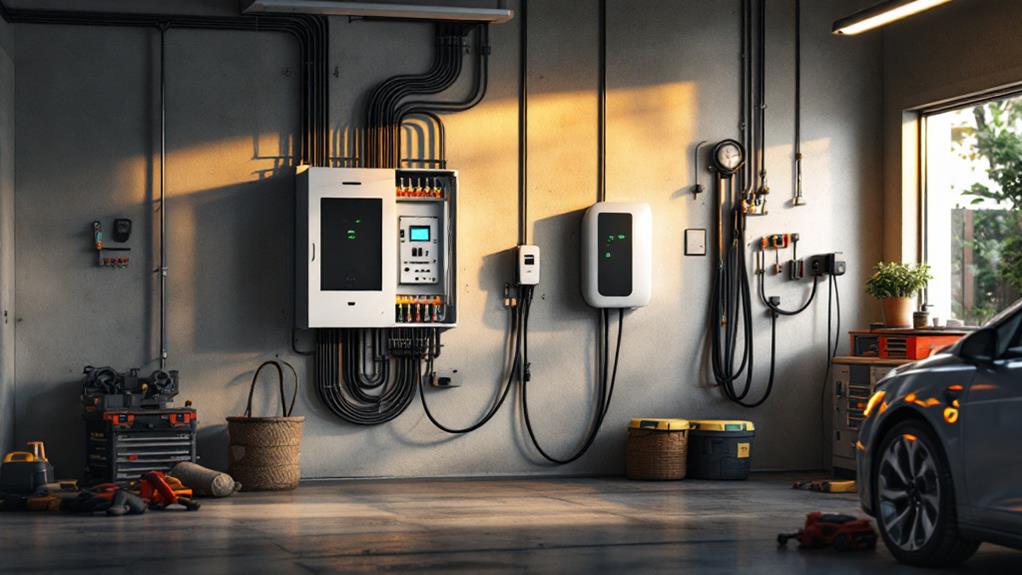
Installing a Level 2 EV charger often requires upgrading your home's electrical panel to meet the increased power demands. To support a 240V, 40-50 amp circuit for your charger, you'll need to verify your electrical system can handle the additional load. Start by having a licensed electrician assess your current setup and determine if an upgrade is necessary.
Key points to consider when upgrading your electrical panel:
- Evaluate your total electrical load and available space for a new circuit breaker
- Decide if you need to upgrade the main service panel or install a subpanel
- Budget for costs ranging from $500 to $2,000 or more, depending on required modifications
- Obtain necessary permits to comply with local electrical codes
- Work with a professional to guarantee safe and compliant installation
Upgrading your electrical panel is a complex task that requires expert knowledge. Your electrician will assess whether your existing service panel can accommodate the new circuit or if you'll need a subpanel to distribute the additional load. They'll also guarantee that all work complies with electrical codes, ensuring a safe and efficient charging setup for your electric vehicle.
Wi-Fi Connectivity Considerations
Smart EV chargers often come equipped with Wi-Fi connectivity, allowing you to remotely monitor and control your charging sessions. This feature enables you to manage your EV charging through a mobile app, offering convenience and energy-saving benefits. To make the most of these smart features, you'll need to secure a strong Wi-Fi signal in your garage.
When installing your EV charger, consider its proximity to your home's Wi-Fi network. Placement within range is pivotal for optimal remote access and integration with smart home systems. You'll want to test the signal strength in your garage and, if necessary, extend your network coverage using a Wi-Fi extender or mesh system.
With a reliable Wi-Fi connection, you can take advantage of features like setting charging schedules, tracking energy usage, and receiving alerts. This connectivity allows you to optimize your charging routine by scheduling sessions during off-peak hours, potentially saving money on electricity costs. Additionally, you can monitor your charging progress remotely and make adjustments as needed. By prioritizing Wi-Fi connectivity for your EV charger, you'll activate its full potential and enhance your overall charging experience.
Future-Proofing Your Installation
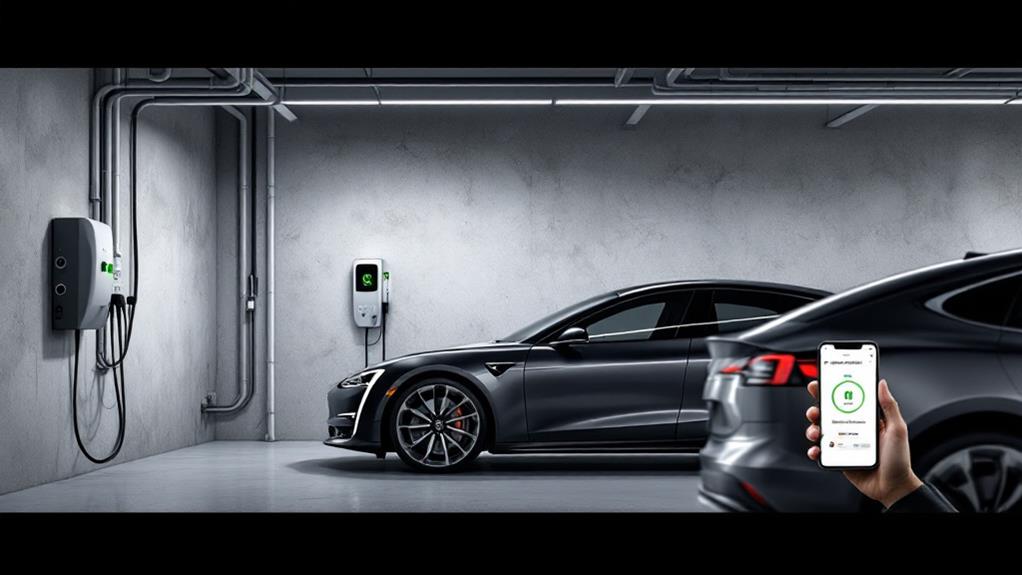
As you set up your Wi-Fi-enabled charging station, it's important to look beyond current needs and plan for the future. When installing your home EV charger, consider these steps to future-proof your installation:
- Choose a Level 2 charger with Wi-Fi connectivity for remote monitoring and updates
- Guarantee your electrical panel has capacity for future upgrades
- Use larger conduits to accommodate potential future cabling needs
- Select a charger compatible with multiple EV models
- Incorporate energy management features for smart charging
By implementing these measures, you'll create a home charging station that adapts to evolving EV technology. Consult with an electrician to assess your electrical panel's capacity and determine if upgrades are necessary. They can help you future-proof the installation by using larger conduits, allowing for easy cable upgrades in the future.
When selecting your EV charging station, opt for a model that supports various vehicle types. This flexibility ensures your charger remains useful even if you switch EVs. Additionally, look for energy management features that enable load balancing and smart charging. These capabilities allow you to adapt to changing electricity rates and grid conditions, optimizing your charging experience and potentially reducing costs. By taking these steps, you'll create a versatile and adaptable home charging solution for years to come.
Maximizing Energy Efficiency
With energy efficiency in mind, you can maximize the benefits of your EV charging station. Your home charging setup can be optimized to enhance both the efficiency of the recharging process and your overall charging experience. Start by programming your charger to operate during off-peak hours when electricity rates are lower. This simple step can lead to significant cost savings over time.
Integrating your EV charger with energy management systems in your home allows for seamless coordination with other smart devices, further optimizing energy usage and reducing electricity bills. Consider investing in smart EV chargers with WiFi connectivity, which enable remote monitoring and adjustment of charging schedules to take advantage of time-of-use rates.
To elevate the environmental benefits of your electric vehicle, install solar panels on your roof. This renewable energy source can power your EV charger, reducing your carbon footprint. For even greater efficiency, pair your charger with a home battery storage system. This combination allows you to charge your vehicle using stored renewable energy, minimizing reliance on the grid and maximizing the sustainability of your home charging setup.
